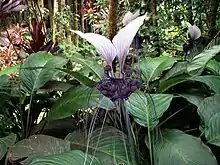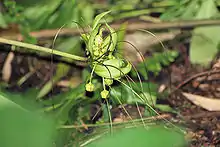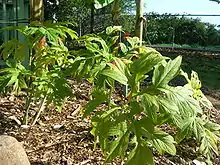Tacca
The genus Tacca, which includes the batflowers and arrowroot, consists of flowering plants in the order Dioscoreales, native to tropical regions of South America, Africa, Australia, Southeast Asia, and various oceanic islands.[1] In older texts, the genus was treated in its own family Taccaceae, but the 2003 APG II system incorporates it into the family Dioscoreaceae.[2] The APG III and APG IV systems continue to include Tacca in Dioscoreaceae.[3][4]
| Bat flowers | |
|---|---|
 | |
| White Bat Flower (Tacca integrifolia) | |
| Scientific classification | |
| Kingdom: | Plantae |
| Clade: | Tracheophytes |
| Clade: | Angiosperms |
| Clade: | Monocots |
| Order: | Dioscoreales |
| Family: | Dioscoreaceae |
| Genus: | Tacca J.R.Forst. & G.Forst. |
| Synonyms[1] | |
| |
Taxonomy
Earlier classifications placed the genus within the monogeneric family Taccaceae, which in turn was the sole family in the order Taccales. Dahlgren recognised the similarities to the genera within the Dioscoreales, and incorporated the family into that order. [5]
Subdivision
There are at least 16 species,[6]
- Tacca ampliplacenta L.Zhang & Q.J.Li - Yunnan
- Tacca ankaranensis Bard.-Vauc., 1997 - Madagascar
- Tacca bibracteata Drenth - Sarawak
- Tacca borneensis Ridl. - Borneo
- Tacca celebica Koord. - Sulawesi
- Tacca chantrieri André, 1901 - Indochina, Assam, Bangladesh, Tibet, Guangdong, Guangxi, Guizhou, Hainan, Hunan, Yunnan
- Tacca ebeltajae Drenth - Papua New Guinea, Solomon Islands
- Tacca integrifolia Ker Gawl., 1812 - Tibet, Bhutan, Assam, Bangladesh, Indochina, India, Pakistan, Java, Malaysia, Sumatra, Borneo
- Tacca leontopetaloides (L.) Kuntze, 1891 - widespread across tropical Africa, Madagascar, Indian Subcontinent, Southeast Asia, New Guinea, Australia, and various islands of the Indian and Pacific Oceans
- Tacca maculata Seem., 1866 - Western Australia, Northern Territory, Fiji, Samoa
- Tacca palmata Blume - Indonesia, Indochina, Malaysia, Philippines, New Guinea
- Tacca palmatifida Baker - Sulawesi
- Tacca parkeri Seem. - South America
- Tacca plantaginea (Hance) Drenth, 1972 - Indochina, southern China
- Tacca reducta P.C.Boyce & S.Julia - Sarawak, Borneo, Malesia
- Tacca subflabellata P.P. Ling & C.T. Ting, 1982 - Yunnan
Cultivation
Several species are cultivated as ornamental plants for their bold foliage and large flowers. The well-known T. chantrieri goes by the names of black batflower, bat-head lily, devil flower or cat's whiskers. Tacca integrifolia is known as the purple or white batflower. Other cultivated varieties include the arrowroot, T. leontopetaloides, and T. cristata aspera.[9][10]
Gallery
 Black bat flower, Tacca chantrieri, close-up of flower
Black bat flower, Tacca chantrieri, close-up of flower Tacca cristata, flowering
Tacca cristata, flowering Ankarana arrowroot, Tacca ankaranensis, flower
Ankarana arrowroot, Tacca ankaranensis, flower Polynesian arrowroot, Tacca leontopetaloides, mature plants
Polynesian arrowroot, Tacca leontopetaloides, mature plants
References
- Kew World Checklist of Selected Plant Families
- Caddick, L. R., P. Wilkin, P. J. Rudall, T. A. J. Hedderson & M. W. Chase. 2002. Yams reclassified: a recircumscription of Dioscoreaceae and Dioscoreales. Taxon 51(1): 103–114.
- Angiosperm Phylogeny Group (2009). "An update of the Angiosperm Phylogeny Group classification for the orders and families of flowering plants: APG III". Botanical Journal of the Linnean Society. 161 (2): 105–121. doi:10.1111/j.1095-8339.2009.00996.x. ISSN 0024-4074. Archived from the original (PDF) on 2017-05-25.CS1 maint: uses authors parameter (link)
- Angiosperm Phylogeny Group (2016). "An update of the Angiosperm Phylogeny Group classification for the orders and families of flowering plants: APG IV". Botanical Journal of the Linnean Society. 181 (1): 1–20. doi:10.1111/boj.12385. ISSN 0024-4074.CS1 maint: uses authors parameter (link)
- Dahlgren & Clifford 1982.
- Catalogue of Life: 2017 Annual Checklist Tacca
- Catalogue (2017)
- Tropicos
- Govaerts, R., Wilkin, P. & Saunders, R.M.K. (2007). World Checklist of Dioscoreales. Yams and their allies: 1-65. The Board of Trustees of the Royal Botanic Gardens, Kew.
- Flora of China, Vol. 24 Page 274, 蒟蒻薯属 ju ruo shu shu, Tacca J. R. Forster & G. Forster, Char. Gen. Pl. 35. 1775.
Bibliography
| Wikimedia Commons has media related to Tacca. |
| Wikispecies has information related to Tacca. |
- Dahlgren, Rolf; Clifford, H. T. (1982). The monocotyledons: A comparative study. London and New York: Academic Press.CS1 maint: ref=harv (link)
- Germplasm Resources Information Network: Tacca
- Taccaceae in L. Watson and M.J. Dallwitz (1992 onwards), The families of flowering plants
- Huxley, A., ed. (1992). New RHS Dictionary of Gardening. Macmillan.